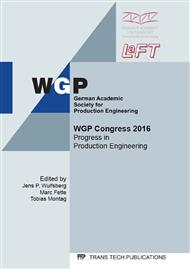p.75
p.83
p.91
p.99
p.107
p.115
p.123
p.133
p.141
Development of a Laser Triangulation Gauge for High Precision Strip Thickness Control
Abstract:
Almost all metal strips with thicknesses of < 2 mm are produced by cold rolling. Thickness variations of cold rolled strips are caused by various factors like fluctuation in strength of the material, the eccentricity of the rolls or thickness variation of the incoming strip. As the demands concerning the thickness variation are ever increasing the Institute of Automatic Control and the Institute of Metal Forming aim at reducing the thickness tolerance of thin, cold-rolled steel and copper strips to 1 μm. As high frequency disturbances are expected, it is assumed that this goal can only be achieved by using a predictive controller in combination with a high precision strip thickness gauge and, for roll adjustment, a piezoelectric actuator in addition to the existing electromechanical actuator. The objective of this work is the constructive implementation and the testing of a thickness gauge based on laser triangulation. The gauge includes guide rollers to prevent strip vibration, a C-frame to allow an inline calibration and mechanical adjustment of the measuring range so that even flexible strip thicknesses can be measured. The designed gauge showed a high repeat accuracy of 0.4 μm for two different metal strips. Furthermore the gauge was used to investigate the dynamics of the thickness change of a steel strip at maximum rolling speed of 5 m/s using a Fourier transformation. This frequency analysis supports the need for a piezoelectric actuator that can also subsequently be dimensioned based on the obtained frequency data.
Info:
Periodical:
Pages:
107-114
Citation:
Online since:
August 2016
Authors:
Keywords:
Price:
Сopyright:
© 2016 Trans Tech Publications Ltd. All Rights Reserved
Share:
Citation:


